Capsule Review: Sapphire's Radeon HD 7870 Overclock Edition
by Ryan Smith on April 28, 2012 4:45 PM EST- Posted in
- GPUs
- AMD
- Sapphire
- Radeon HD 7000
As AMD’s 28nm allocation has improved so has the selection of cards available on the market. We’re still in the first phase of the Radeon HD 7000 series rollout, with AMD’s partners building semi-custom cards based on AMD’s reference PCB, but even without custom PCBs AMD’s partners have been able to turn out a number of interesting designs. This is particularly the case for the 7800 series, where prices are high enough for partners to experiment with different coolers and TDPs are low enough to allow more than a handful of approaches.
Last month we saw some of those first designs with PowerColor’s PCS+ HD7870 and HIS’s IceQ 7870 Turbo, and today we’ll be looking at a third: Sapphire’s HD 7870 Overclock Edition, their semi-custom factory overclocked 7870. How does Sapphire’s dual-fan entry stand up to the competition? Let’s find out.
| Radeon HD 7870 Partner Card Specification Comparison | ||||||
| Sapphire HD 7870 Overclock Edition | PowerColor PCS+ HD7870 | HIS IceQ Turbo 7870 | AMD Radeon HD 7870 (Ref) | |||
| Stream Processors | 1280 | 1280 | 1280 | 1280 | ||
| Texture Units | 80 | 80 | 80 | 80 | ||
| ROPs | 32 | 32 | 32 | 32 | ||
| Core Clock | 1050MHz | 1100MHz | 1100MHz | 1000MHz | ||
| Memory Clock | 5GHz GDDR5 | 4.9GHz GDDR5 | 4.8GHz GDDR5 | 4.8GHz GDDR5 | ||
| Memory Bus Width | 256-bit | 256-bit | 256-bit | 256-bit | ||
| Frame Buffer | 2GB | 2GB | 2GB | 2GB | ||
| PowerTune Limit | 190W | 190W | 190W | 190W | ||
| Manufacturing Process | TSMC 28nm | TSMC 28nm | TSMC 28nm | TSMC 28nm | ||
| Width | Double Slot | Double Slot | Triple Slot | Double Slot | ||
| Length | 10" | 9.5" | 11.25" | 9.5" | ||
| Warranty | 2 Years | 2 Years | 2 Years | N/A | ||
| Price Point | $359 | $369 | $389 | $349 | ||
Like the other 7870 cards we have reviewed so far, Sapphire’s HD 7870 Overclock Edition is a semi-custom card, meaning Sapphire is using an AMD reference board equipped with their own cooler. On top of the cooler Sapphire adds one further degree of customization here, as this is an Overclock Edition card, meaning it ships with a factory overclock. Sapphire is shipping the card with a modest boost to both core and memory clocks, shipping at 1050MHz core and 5GHz memory, representing a 50MHz (5%) core overclock and a 200MHz (4%) overclock over the stock 7870. This isn’t as aggressive as what we’ve seen PowerColor and HIS do, but then the price premium isn’t nearly at high either.
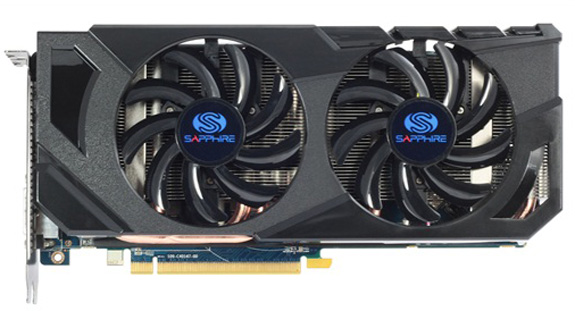
Breaking down the card, Sapphire’s cooler of choice is a slightly smaller version of their Dual-X cooler. The Dual-X is your typical double-wide dual-fan open air cooler, with 2 fans providing copious airflow over an aluminum heatsink running virtually the entire length of the card. As with the larger Dual-X cooler we saw on their 7950, the Dual-X on the 7870 is slightly oversized, allowing for slightly larger fans. In exchange the Dual-X on the 7870 is about 10mm taller than the PCB, and 0.5” longer than the 7870 PCB, pushing the card out to 10” long.
Meanwhile contact with the GPU is provided through an aluminum baseplate. Embedded in the baseplate are the card’s 4 copper heatpipes, which in turn run to various locations on the heatsink. Elsewhere Sapphire uses a small aluminum plate covering part of the PCB to function as a heatsink for the GDDR5 RAM.
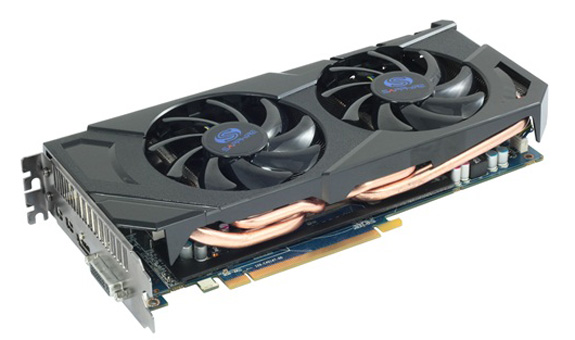
Unfortunately while Sapphire has built a good cooler for the 7870, they’ve done a subpar job on overall build quality. The cooler itself is fine, but like most other dual-fan coolers it’s only secured to the PCB around the GPU, meaning additional support for the PCB is required. In place of a full shroud providing stability there should be a stiffener running along the card, and while Sapphire’s aluminum plate provides some support it’s not nearly long enough. As a result roughly a third of the card – the tail-end portion of the card farthest from the GPU – doesn’t have any kind of support, leaving the PCB free to flex. This oversight isn’t likely to result in damage so this isn’t a dealbreaker, but at this point we’ve come to expect better, especially for cards in this price range. It goes without saying that handling the tail-end of the PCB should be avoided.
Wrapping up our look at the design of the card, as this is an AMD reference PCB the rest of the card uses the same 7870 design we’ve seen before. At the tail-end of the card are 2 6-pin PCIe power sockets, which are a bit harder to reach thanks to the oversized cooler, but not altogether difficult. Meanwhile at the front Sapphire is using AMD’s standard port configuration for display connectivity: 2 miniDPs, 1 HDMI port, and 1 DL-DVI port. Unlike some of the other 7870 cards we’ve seen, Sapphire is not using the optional second DVI port, so a full size vent is present.
Rounding out the package is the usual collection of dongles and materials. Sapphire includes 2 molex-to-6pin PCIe adaptors, an HDMI to DVI dongle, a miniDP to DisplayPort dongle, a DVI to VGA dongle, a CrossFire bridge, and a 1.8m HDMI cable. Along with the dongles Sapphire packs a quick start guide and a driver installation CD. As the driver CD itself is rather barebones Sapphire doesn’t include a copy of their TriXX overclocking utility, but at this point it wouldn’t do you any good anyhow – Sapphire has yet to update TriXX to support the 7800 series, so it can’t properly read the card. For overclocking you’ll need to use Overdrive or other 3rd party overclocking utilities.
Finally, let’s talk about pricing and warranties. Sapphire is selling the HD 7870 OE for $359, only $10 over AMD’s $349 Radeon HD 7870 MSRP. As Sapphire uses the same Dual-X cooler on their stock-clocked 7870 the $10 premium is entirely for the factory overclock, and while a similar 5% overclock should be easily attainable on virtually all 7870 cards, as far as factory overclock pricing is concerned $10 for 5% more is a reasonable deal here. As for the warranty, the HD 7870 OE ships with Sapphire’s standard 2 year warranty.
Performance
So how does the HD 7870 perform? Since the biggest differentiating factor among AMD’s partners right now is their choice of coolers, let’s start there.
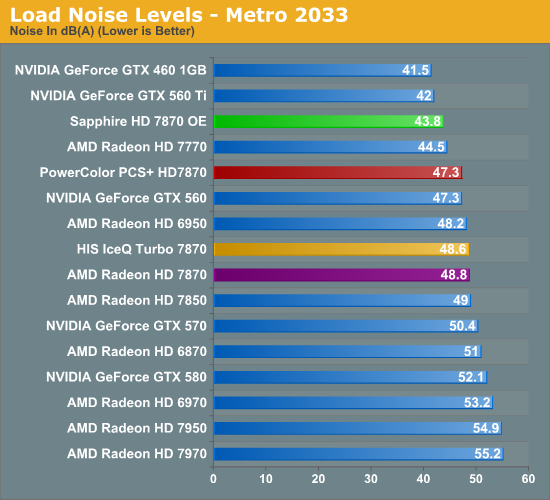
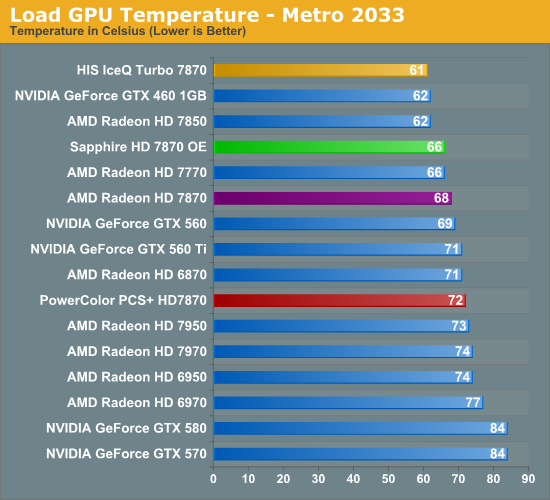
As we’ve come to expect from the Dual-X and other open air coolers, Sapphire’s cooler does very well here. Under Metro it’s by far the quietest 7870 we’ve tested, coming in at only 43.8dB, which makes it quieter than even the reference 7770 and only a few dB over our noise floor. Sapphire doesn’t make any temperature tradeoffs here either, hitting a quite cool 66C, 2C cooler than the reference 7870 and its fully enclosed blower design. With that said, the use of an open air cooler is a tradeoff in and of itself, and like other open air cards Sapphire’s 7870 needs a case with good airflow to breathe since it ends up recycling hot air.
The HD 7870 OE’s gaming performance on the other hand is not particularly exceptional for 7870 cards. The performance of the 7870 scales well with clockspeed so gaming performance benefits from Sapphire’s 5% core overclock in most situations, but looking at the big picture 5% isn’t a huge difference. In the case of Battlefield 3 it’s enough to nudge performance over 60fps, but it isn’t going to significantly change your playable settings. Ultimately there’s not a lot Sapphire can do here, as the 7870 being the higher tier 7800 series card means that it’s already running closer to the limit of the Pitcairn GPU.
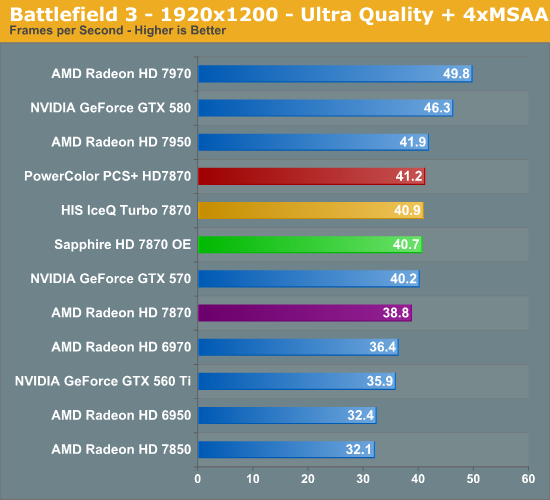
Overclocking can push the card a bit farther of course. In this case we hit 1150MHz core and 5.4GHz memory, which is a bit lower than what we’ve hit with other 7870s but since all of these cards are using the same PCB it’s purely the luck of the draw.
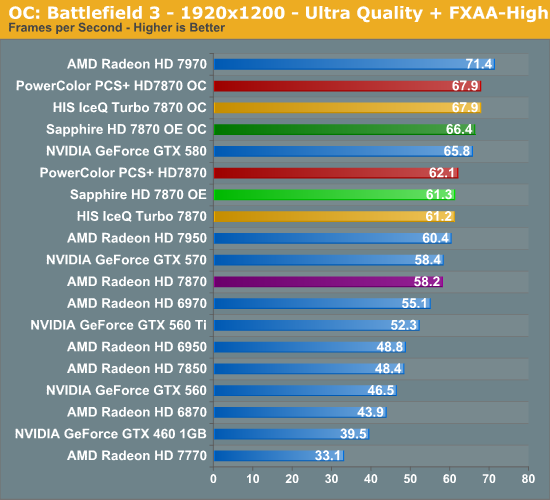
Final Words
At this point we’ve looked at several different Radeon HD 7870 designs, open air and closed blowers, extreme performance and balanced designs alike. To that end Sapphire’s HD 7870 OE fits in well with the balanced group, offering a decent factory overclock alongside a conventional but effective cooler. The subpar build quality of the card keeps it from being a true superstar, but otherwise Sapphire has done a good job here of balancing every aspect of the HD 7870 OE to make the card a solid performer.
The end result of Sapphire’s efforts is that of all the 7870 cards we’ve looked at the HD 7870 OE is easily the quietest and it doesn’t make any temperature compromises to get there. Hardcore overclockers will likely want a bit more, but for more traditional gamers with cases that can handle open air coolers this is the semi-custom 7870 to get – the HD 7870 OE offers all of the performance of a 7870 and more, and it does so with as little noise as possible. From a noise/performance perspective the 7870 is the current sweet spot, and Sapphire’s HD 7870 OE is sitting right in the middle of it.
















37 Comments
View All Comments
Galidou - Tuesday, May 1, 2012 - link
LOL CeriseCogburn, don't be such a mad fanboy... Answering to a simple inflammaroty sentence with a whole paragraph... Go buy a GTX 680 and throw eggs at AMD's headquarter like you were doing before commenting here :POrigin32 - Sunday, April 29, 2012 - link
And another typical day at Anand. AMD fanboys accusing writers of being Intel fanboys and Nvidia fanboys accusing them of being AMD fanboys. lolSpunjji - Friday, May 11, 2012 - link
It's tiring, isn't it.vicbee - Monday, April 30, 2012 - link
Ya'll should just get a life. Seriously... most arguments revolve around $10-30 price difference and possibly 10 fps for similar card category. Yawn!Until last week I have a liquid cooled GTX285 until a transistors fried. I was kind of glad something happened because I wanted a newer card but just couldn't fathom taking my rig apart to uninstall the liquid circuit. And who in their right mind would buy a 2nd hand card with a liquid cooling add-on... problem solved.
I've only owned higher end Nvidia cards so this time around I thought I'd try an AMD and got the Sapphire discussed in this article. It's a great card (like my Nvidia cards were great cards) and because it's an upgrade I get 20 fps more than with the old card. I did have a software install issue tied to a missing something .dll but on the 3rd download it solved itself. Problem solved now back to gaming...
Autisticgramma - Monday, April 30, 2012 - link
@CeriseCogburn. You doth protest too much.Next you'll be telling us that nVidia's Tegra 2 is better than the (new AMD card).
nVidia Isn't innovating, its reacting to AMD offerings. (in the desktop graphics realm) Granted most of the cards are about 10% better, and about three months later for about the same price.
When Fermi was released, it was obviously a data center add in card, the price, the heat and performance (for graphics) was outrageous.
I Tend to agree with the nVidia fan boys that they're (nVidia) holding stuff back, kepler looks good on paper, and the point of availability has been pounded to death.
If they can crush AMD, why don't they?
I'd be happy to give them my money, if they weren't the lazy hare in this race.
-gramma
Stempy59 - Monday, May 7, 2012 - link
Hmn, under clocked 680 still better, yeah the price is higher but they will be more available soon!Spunjji - Friday, May 11, 2012 - link
Thank-you for that enlightening apples-to-oranges comparison. Meanwhile it was nice to see how AMD's second-tier card stacks up (better than its top-tier card, hilariously).